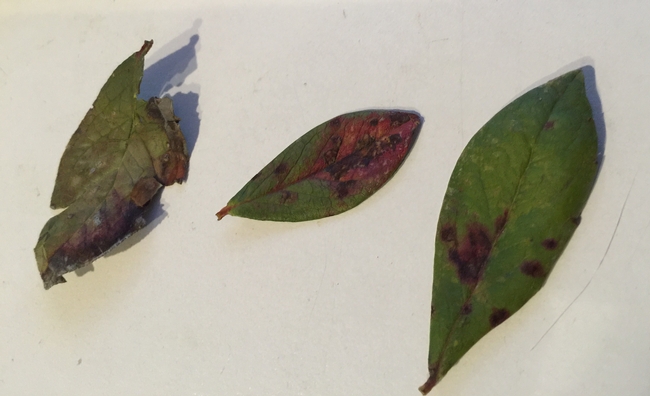Advice for the Home Gardener from the Help Desk of the
UC Master Gardener Program of Contra Costa County

Help Desk Response: Thank you for emailing the photos of the spots on your blueberry leaves. While we are unable to specifically identify the disease with certainty, it is highly likely that the spots are caused by a type of Anthracnose leaf spot fungus.
This and most other fungus diseases thrive in cool wet weather such as we have had this past year. The Anthracnose fungus has been identified on blueberries by researchers at the University of Oregon. The University of California recommends a number of measures that can be undertaken to control fungus. In general, it is recommended that you select resistant varieties and planting should be in the full sun. Other recommended practices for reducing fungal diseases include the following:
- Prune diseased growth as it appears.
- Provide drip irrigation if possible, otherwise irrigate in the early morning using mini-sprinklers.
- Avoid over fertilizing.
- Prune in the winter to increase air circulation.
- Once you have cleaned up diseased material from the plant and soil, place a generous amount (3 inches deep) of mulch on the soil below the plant canopy. This will help trap fungal spores so they don't splash up and re-infect the plant.
Hopefully implementing these practices and the onset of dryer, hotter weather will reduce the spread and minimize damage caused by the fungus.
There are also a number of additional recommendations for how to plant blueberries in a manner that will increase the plant health and resistance to stressors including diseases. These include:
- Select a variety bred to do well in California soil and known to do well in hot areas. These include Emerald, Jewel and Star.
- Plant in acidic (pH of 4.5-5.5), well-drained soil.
Blueberries belong to the Ericaceae family, which also includes other acid-loving plants such as azalea and rhododendrons . These plants need higher acidity to uptake needed nutrients. Contra Costa soils are generally slightly acidic to moderately alkaline. You can test your soil pH using a kit purchased from your local nursery. If you need to increase acidity, amend the soil six months prior to planting with 6-12 lbs. of aluminum sulfate per 100 square feet of garden. This will increase acidity by one pH unit (from 6 to 5). Another option is to plant them in raised beds (8-18 inches high by 3-4 feet wide) or a large pot. This allows you to more easily manage the soil pH and drainage. - Plant in a location where there is minimal frost and wind.
- Add mulch, which is usually slightly acidic and releases beneficial elements gradually and supports beneficial microbial organisms. Liquid fertilizers can be too strong. If using, apply four weeks after planting with a 10-10-10 mixture and reduce the amount recommended on the label. If using organic fertilizer apply one pound of blood, feather, or fish meal for each plant.
- Irrigate to maintain moist but not wet soil as blueberry roots are vulnerable to root rot.
- Hand weed to avoid damaging fragile surface roots.
If you would like additional information about blueberry varieties and growing tips, you can find it at: http://ucanr.edu/sites/gardenweb/berries/blueberries/
In addition, the UC Master Gardener Program of Contra Costa County is holding a program on Successfully Growing Blueberries at "Our Garden" on May 17th from 9am to noon. The main program will be presented at 10am by Kathy Echols, long-time DVC horticulture instructor. Our Garden is located in Walnut Creek at the corner of N. Wiget Lane and Shadelands Drive.
Thank you for contacting our UC Master Gardener Program. Please feel free to re-contact us with further questions.
Help Desk of the UC Master Gardener Program of Contra Costa County (NPH)
Note: The UC Master Gardeners Program of Contra Costa's Help Desk is available year-round to answer your gardening questions. Except for a few holidays, we're open every week, Monday through Thursday for walk-ins from 9:00 am to Noon at 75 Santa Barbara Road, 2d Floor, Pleasant Hill, CA 94523. We can also be reached via telephone: (925) 646-6586, email: ccmg@ucanr.edu, or on the web at http://ccmg.ucanr.edu/Ask_Us/ MGCC Blogs can be found at http://ccmg.ucanr.edu/HortCoCo/ You can also subscribe to the Blog (//ucanr.edu/blogs/CCMGBlog/).